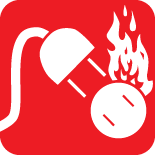All Fires is not same it is classified as per below. Fire extinguisher is selected according to Type of fire.
Class A Fire: Ordinary Fire
Class A fires are fires in ordinary combustibles such as wood, paper, cloth, rubber, and many plastics.
Fire Extinguishing Method: Water, Smothering
Extinguisher: ABC Powder, water, water mist, foam
Class B Fire: Liquid & Gas Fire
Class B fires are fires in flammable liquids such as gasoline, petroleum oils, oil-based paints, solvents, alcohols, flammable gases such as propane and butane.
Class B fires do not include fires involving cooking oils and grease.
Fire Extinguishing Method: Smothering
Extinguisher: ABC Powder, CO2, water mist, clean agent
Class C Fire: Electrical Fires
Class C fires are fires involving energized electrical equipment such as motors, lightings, computers, transformers, and equipment's.
Remove the power and the Class C fire becomes one of the other classes of fire.
Fire Extinguishing Method: Use of Non-conductive chemicals
Extinguisher: ABC Powder, CO2, clean agent
Class D Fire: Metal Fire
Class D fires are fires in combustible metals such as magnesium, titanium, zirconium, sodium, lithium, and potassium.
This fire should not extinguish with Water, If water use it will release harmful gases.
Fire Extinguishing Method: Dry powder agent
Extinguisher: Dry Chemical Powder, Sand
Class K Fire
Some types of fire extinguishing agents can be used on more than one class of fire. Others have warnings where it would be dangerous for the operator to use on a particular fire extinguishing agent.
Fire Extinguishing Method: Cooking or grease fire
Extinguisher: Wet chemical





